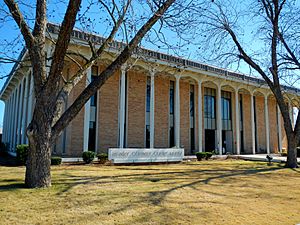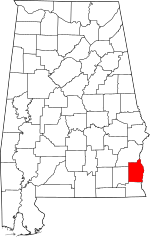Henry County, Alabama facts for kids
Quick facts for kids
Henry County
|
|||||
|---|---|---|---|---|---|

Henry County Courthouse in Abbeville
|
|||||
|
|||||

Location within the U.S. state of Alabama
|
|||||
 Alabama's location within the U.S. |
|||||
| Country | |||||
| State | |||||
| Founded | December 13, 1819 | ||||
| Named for | Patrick Henry | ||||
| Seat | Abbeville | ||||
| Largest city | Headland | ||||
| Area | |||||
| • Total | 568 sq mi (1,470 km2) | ||||
| • Land | 562 sq mi (1,460 km2) | ||||
| • Water | 6.6 sq mi (17 km2) 1.2% | ||||
| Population
(2020)
|
|||||
| • Total | 17,146 | ||||
| • Estimate
(2023)
|
17,899 |
||||
| • Density | 30.187/sq mi (11.655/km2) | ||||
| Time zone | UTC−6 (Central) | ||||
| • Summer (DST) | UTC−5 (CDT) | ||||
| Congressional district | 2nd | ||||
|
|||||
Henry County is a county located in the southeastern part of Alabama, a U.S. state. In 2020, about 17,146 people lived there. The main town and county seat is Abbeville.
The county is named after Patrick Henry (1736–1799). He was a famous speaker and a governor of Virginia. Henry County is also part of the Dothan area.
Contents
History of Henry County
Before it became a county, the area of Henry County was part of British West Florida between 1763 and 1783. Henry County was officially created on December 13, 1819. This happened thanks to the Alabama Territorial Legislature.
The land was given up by the Creek Indian Nation in 1814. This was part of the Treaty of Fort Jackson. Henry County was formed even before Alabama became a state. For thousands of years, different groups of indigenous peoples lived here. Abbeville became the county seat in 1833.
When it was first formed, Henry County was the largest county in Alabama. It included parts of what are now many other counties. These include Barbour, Coffee, Covington, Crenshaw, Dale, Geneva, Houston, and Pike. In 1903, when Houston County was formed, Henry County became the smallest.
After 1814, the first European settlement in the Creek territory was Franklin. This town was a river port for Abbeville on the Chattahoochee River. Much of the original Henry County was part of the wiregrass region of Alabama.
Geography of Henry County
The U.S. Census Bureau says Henry County covers about 568 square miles. About 562 square miles are land, and 6.6 square miles (1.2%) are water. It is the fourth-smallest county in Alabama by total area.
Main Roads
Neighboring Counties
- Barbour County (north)
- Clay County, Georgia (northeast)
- Early County, Georgia (southeast)
- Houston County (south)
- Dale County (west)
People of Henry County
| Historical population | |||
|---|---|---|---|
| Census | Pop. | %± | |
| 1820 | 2,638 | — | |
| 1830 | 4,020 | 52.4% | |
| 1840 | 5,787 | 44.0% | |
| 1850 | 9,019 | 55.8% | |
| 1860 | 14,918 | 65.4% | |
| 1870 | 14,191 | −4.9% | |
| 1880 | 18,761 | 32.2% | |
| 1890 | 24,847 | 32.4% | |
| 1900 | 36,147 | 45.5% | |
| 1910 | 20,943 | −42.1% | |
| 1920 | 21,547 | 2.9% | |
| 1930 | 22,820 | 5.9% | |
| 1940 | 21,912 | −4.0% | |
| 1950 | 18,674 | −14.8% | |
| 1960 | 15,286 | −18.1% | |
| 1970 | 13,254 | −13.3% | |
| 1980 | 15,302 | 15.5% | |
| 1990 | 15,374 | 0.5% | |
| 2000 | 16,310 | 6.1% | |
| 2010 | 17,302 | 6.1% | |
| 2020 | 17,146 | −0.9% | |
| 2023 (est.) | 17,899 | 3.5% | |
| U.S. Decennial Census 1790–1960 1900–1990 1990–2000 2010–2020 |
|||
2020 Census Information
| Race | Number of People | Percentage |
|---|---|---|
| White (not Hispanic) | 11,842 | 69.07% |
| Black or African American (not Hispanic) | 4,232 | 24.68% |
| Native American | 50 | 0.29% |
| Asian | 73 | 0.43% |
| Other/Mixed | 615 | 3.59% |
| Hispanic or Latino | 334 | 1.95% |
In 2020, there were 17,146 people living in Henry County. There were 6,630 households and 4,505 families.
2010 Census Information
In 2010, Henry County had 17,302 people. There were 6,994 households and 4,975 families. The population density was about 31 people per square mile.
The racial makeup was mostly White (68.6%) and Black or African American (28.6%). A small number of people were Native American (0.3%) or Asian (0.3%). About 2.2% of the population was Hispanic or Latino.
Religion
Many churches were already in the southern part of the county. One example is Ramah Church. In 1876, Ramah Primitive Baptist Church opened in that area.
Communities in Henry County
Cities
- Abbeville (the county seat)
- Dothan (partly in Dale County and Houston County)
- Headland
Towns
Unincorporated Communities
These are smaller places that are not officially cities or towns.
See also
 In Spanish: Condado de Henry (Alabama) para niños
In Spanish: Condado de Henry (Alabama) para niños




